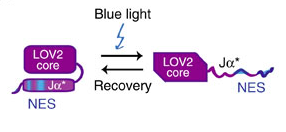Optogenetics is one of the flashier techniques of the past decade. Instead of slow chemical or blunt physical interventions, optogenetics controls events inside cells with the timing and precision of a beam of light. Optogenetic success stories thus far include light-activated neuron firing, heart beating, organelle positioning, protein dimerization, membrane localization, gene editing, and import into the nucleus.
Until now, nuclear export has failed to conform, but that just changed, thanks to a brilliant flash of inspiration. Dominik Niopek, working with Barbara Di Ventura at the University of Heidelberg, has developed a light-inducible nuclear export system that they call LEXY, which exports tagged proteins from the cell nucleus when hit with blue light.

When LEXY is hit with blue light, the engineered NES-containing alpha helix unfolds, causing nuclear export. Image via Niopek et al.
The system is based on LOV2, a natural light-sensing protein domain with an alpha helix that unfolds in response to blue light. Using some clever engineering, which they call “helix topping”, the team gradually introduced changes to the natural alpha helix to make it more like a canonical nuclear export sequence (NES). After only two rounds of making and screening candidate libraries, they found a nice, well-behaved sequence.
This helix-topping approach preserved the structure of the original alpha helix, and it was more elegant than simply plopping a whole NES inside the alpha helix and hoping it wouldn’t screw things up. The final system had some nice specs:
- Export was fast – half times were less than 1 minute.
- Nuclear localization recovered in the dark, with full recovery in about 15 minutes.
- LEXY worked in multiple cell types, from mouse to human.
- LEXY even exported proteins with native import sequences, including Sox2 and Nanog.
- Tagged repressor proteins allowed light-regulated transcription of target genes.
- Tagging the tumor-suppressing transcription factor p53 allowed the team to precisely control it in space and time, which could be quite a useful tool for cancer research.
In one final neat trick, the team found that tagging the chromatin-anchored histone H2B with LEXY actually clogged the CRM1 nuclear exporters, which blocked export of other cargo. Since chemical nuclear export inhibitors are imprecise and toxic, this optogenetic export inhibition could be a boon for research.
For more, export your eyeballs over to Nature Communications, 2016.



